Assessment of Geological Factors Responsible For Gas Entrapment in Two Nigerian Coals and Syngas Extraction Using Locally Fabricated Gasification Plant
Abstract
Olugbenga Ajayi Ehinola, Kehinde Joseph Egunjobi, Ibrahim Adedayo Oladosu, Olugbenga Adebanjo Falode, Oladotun Afolabi Oluwajana
Of all the fossil fuel sources, Coal Bed Methane (CBM) is the least expensive for its energy content. This study aimed at assessing the geological factors that may be responsible for gas emplacement in Nigerian coal and syngas extraction using a locally fabricated gasification plant. Trace element, sulfur content, XRay diffraction, and Scan Electron Microscope analysis of coal samples from Ute and Okaba were carried out to determine geological factors such as depositional environment, ineralogy, and pore morphology that affects the emplacement of gas in coals and its extraction. The syngas was then extracted from Okaba and Ute coal using the fabricated gasification plant which consists of a reactor, water jacket to regulate body temperature, a blower to allow continuous inflow of air, cyclone filter to filter the syngas from the impurity, compressor, and a cylinder to collect and store the gas. The coal samples were heated to a temperature range of 500 -1000 0C. The value of the V/Ni ratio of the coals ranged from 0.35 to 3.75 ppm. Also, plots of V/Cr and Ni/Co ratios indicated predominantly oxic conditions during sediment accumulation. The low V/(V+Ni) ratio (0.26- 0.0.79 ppm) also confirmed that the coal samples were deposited under oxic conditions. By implication, the sulfur content in the Okaba and Ute coal with the range of 0.85 - 2.33% originated from parent plant material deposited in a lacustrine environment. The coal samples contain brittle minerals such as quartz and Kaolinitic clay that also allow the creation of natural fractures and could provide induced fractures under artificial fracturing force which is conducive to coal gas exploration. The pore and racture diameters observed in coal samples from Okaba and Ute are classified as microfracture and macropores, respectively, implying that the coal can serve as a reservoir for coal bed methane (CBM) and that the linkage of the fractures and pores results in high permeability which in turn will allow the coal to easily release the gas it is storing when heated. The syngas extracted from Okaba and Ute coal consists of a mixture of N2, H2, CO2, and CH4 which can either be used upon purification for transport, chemicals production, heat, and power generation. It can be deduced that the coal samples from the study area (Okaba and Ute) are capable of storing gas which in turn can be extracted and used by gasification method which has a minimal environmental effect because the gasification plant reduces CO2 emission by 90% as compared with direct combustion of coal.



